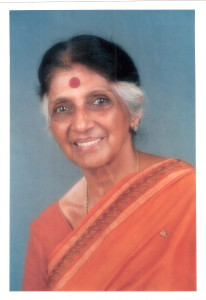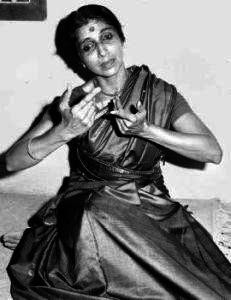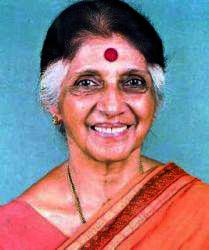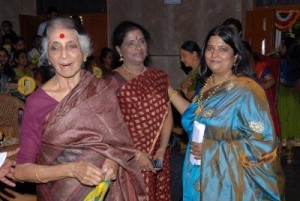Author: Editor and Co-authors
ಪ್ರಾಂಜಲ ಮನಸ್ಸಿನಿಂದ ನೃತ್ಯಕ್ಷೇತ್ರಕ್ಕೆ ಸೇವೆ ಸಲ್ಲಿಸಿದ; ಅಧ್ಯಯನ, ಪ್ರಯೋಗವೆರಡರಲ್ಲೂ ಸಮಾನಾಸಕ್ತಿ ಹೊಂದಿ ಗುರು-ಹಿರಿಯರಿಗೆ, ಸಮಕಾಲೀನರಿಗೆ ಮತ್ತು ಯುವಚೈತನ್ಯಗಳಿಗೆ ಸ್ಪೂರ್ತಿದಾಯಕವಾಗಿ ದುಡಿಯುತ್ತಿರುವ ಹಿರಿಯರಿಗೆ 2012ರಲ್ಲಿ ನೂಪುರ ಭ್ರಮರಿ ನೃತ್ಯ ಸಂಶೋಧಕರ ಚಾವಡಿಯು ನೀಡಿದ ಪ್ರಥಮ ಪುರಸ್ಕಾರವಾಗಿತ್ತು. ನೂಪುರ ಭ್ರಮರಿಯ ಆಶಯ, ಉದ್ದೇಶಗಳಿಗೆ ಅನುರೂಪವಾಗಿದ್ದವರಿಗೆ ನೀಡಿ ಧನ್ಯರಾಗುವ ಪುರಸ್ಕಾರವದು- ‘ನೂಪುರ ಕಲಾಕಲಹಂಸ’. ಇಂತಹ ಧನ್ಯತೆಗೆ ನಮ್ಮನ್ನು ಭಾಜನರಾಗಿಸಿ ವಾತ್ಸಲ್ಯದ ಸುಧೆಯನ್ನು ಹರಿಸಿದವರು ಇತ್ತೀಚೆಗಷ್ಟೇ ತಮ್ಮ 88ರ ಇಳಿವಯಸ್ಸಿನಲ್ಲಿ ನಮ್ಮೆಲ್ಲರನ್ನು (ಮಾರ್ಚ್ 2015) ಅಗಲಿಹೋಗಿರುವ ಬೆಂಗಳೂರಿನ ಹಿರಿಯ ನೃತ್ಯಕಲಾವಿದೆ ವಿದುಷಿ ಲೀಲಾರಾಮನಾಥನ್.

ನೃತ್ಯಕಲಿಕೆಗೆ ಅಷ್ಟಾಗಿ ಪ್ರೋತ್ಸಾಹವಿರದಿದ್ದ ಕಾಲದಲ್ಲಿ ಬಡವಬಲ್ಲಿದರೆನ್ನದೆ ತಾವು ನೃತ್ಯ ಕಲಿಸಿದಷ್ಟೂ ಕಾಲ ವಿದ್ಯಾರ್ಥಿಗಳಿಂದ ಚಿಕ್ಕಾಸನ್ನೂ ಪಡೆಯದೆ ನಿಸ್ವಾರ್ಥಪ್ರೇಮದಲ್ಲಿ ಕಲೆಯನ್ನು ಪೋಷಿಸಿದವರು ಶ್ರೀಮತಿ ಲೀಲಾ ರಾಮನಾಥನ್. ತಾವು ನೀಡಿದ ನೃತ್ಯಪ್ರದರ್ಶನಗಳ ಆದ್ಯಂತವೂ ಪಕ್ಕವಾದ್ಯದವರನ್ನು ಪೋಷಿಸಿ ಕೂಡಾ ಆಯೋಜಕರಿಂದ ತನಗಾಗಿ ಸಂಭಾವನೆಯನ್ನೂ ಪಡೆಯಲು ಇಚ್ಛಿಸದೆ ಹೂವು-ಹಣ್ಣುಗಳ ಫಲವಂತಿಕೆಯಲ್ಲೇ ಜೀವನದ ಅರ್ಥವಂತಿಕೆಯನ್ನು ಕಂಡವರು. ವೃದ್ಧಾಪ್ಯದ ತೊಂದರೆಗಳ ನಡುವೆಯೂ ನೃತ್ಯ, ಕಲೆಯೆಂದಾಕ್ಷಣ ಆನಂದಭಾಷ್ಪವನ್ನೇ ಸುರಿಸುವ ಲೀಲಾ ಅವರದ್ದು ಕರ್ನಾಟಕದ ಪ್ರಬುದ್ಧ ಚಿಂತನೆಯ ನೃತ್ಯಗುರುಗಳ ಪೈಕಿ ಮೇಲ್ಪಂಕ್ತಿ.
ಲೀಲಾ ಅವರ ತಾತ ರಾಜಮಂತ್ರಪ್ರವೀಣ ಎಚ್. ವಿ. ನಂಜುಂಡಯ್ಯನವರು ಮೈಸೂರು ವಿಶ್ವವಿದ್ಯಾಲಯದ ಸ್ಥಾಪಕ ಕುಲಪತಿ ಹಾಗೂ ಕನ್ನಡ ಸಾಹಿತ್ಯ ಪರಿಷತ್ತಿನ ಸಂಸ್ಥಾಪಕ ಸದಸ್ಯರಾಗಿದ್ದರು. ಲೀಲಾ ಅವರ ತಂದೆ ಸಿ. ಭಾಸ್ಕರಯ್ಯ ಭಾರತದ ಉಪಮಹಾಲೇಖಪಾಲರಾಗಿದ್ದರು. ಇಂತಹ ವಿದ್ಯಾಸಂಸ್ಕಾರವುಳ್ಳ ಮನೆಯಲ್ಲಿ ಬೆಳೆದ ಲೀಲಾಗೆ ಮಹಾರಾಣಿ ಕಾಲೇಜಿನಲ್ಲಿ ಪಾಠ ಮಾಡುತ್ತಲೇ ಇಂಗ್ಲಿಷ್ ಸಾಹಿತ್ಯದಲ್ಲಿ ಸ್ನಾತಕೋತ್ತರ ಆನರ್ಸ್ನ್ನು ಚಿನ್ನದ ಪದಕದೊಂದಿಗೆ ಪೂರೈಸುವುದೆಂದರೆ ನೀರು ಕುಡಿದಷ್ಟೇ ಸಲೀಸಾಗಿತ್ತು. ನಂತರ ಆಕ್ಸ್ಫರ್ಡ್ ಕಾಲೇಜಿನಲ್ಲಿ ಇಂಗ್ಲಿಷ್ ಸಾಹಿತ್ಯದ ಸಂಶೋಧನೆ ನಡೆಸಲು ಅವಕಾಶ ದೊರೆತರೂ ಅದನ್ನು ಬದಿಗಿರಿಸಿದ್ದರು. ಕಾರಣ, ತಮ್ಮ ಪ್ರೀತಿಯ ನರ್ತನ !

ಲೀಲಾ ಅವರ ಮೊದಲ ನೃತ್ಯಪ್ರದರ್ಶನ ನಡೆದಿದ್ದು ಬೆಂಗಳೂರಿನ ಪುಟ್ಟಣ್ಣಚೆಟ್ಟಿ ಕಲಾಕ್ಷೇತ್ರದಲ್ಲಿ. ಕೋಲಾರ ಪುಟ್ಟಪ್ಪ, ಮೀನಾಕ್ಷಿ ಸುಂದರಂ ಪಿಳ್ಳೈ, ಮೈಲಾಪುರ ಗೌರಿ ಅಮ್ಮಾಳ್ ಮತ್ತು ಕಿಟ್ಟಪ್ಪ ಪಿಳ್ಳೈರಂತಹ ನೃತ್ಯಕ್ಷೇತ್ರದ ಅತಿರಥ-ಮಹಾರಥರಲ್ಲಿ ಪಳಗಿದವರು ಲೀಲಾ ರಾಮನಾಥನ್. ಕಥಕ್ಕಳಿಯನ್ನು ಚಂದು ಪಣಿಕ್ಕರ್, ಕಥಕ್ ನೃತ್ಯಶೈಲಿಯನ್ನು ಚೌರಿ ಪ್ರಸಾದ್ ಮತ್ತು ಸೋಹನ್ ಲಾಲ್ ಅವರಿಂದ, ಒಡಿಸ್ಸಿಯನ್ನು ದೇಬು ಪ್ರಸಾದ್ದಾಸ್ ಅವರಲ್ಲಿ ಕಲಿತರು. ಪ್ರಧಾನಮಂತ್ರಿ ಜವಾಹರಲಾಲ್ ನೆಹರು ಅವರ ನಿರ್ದೇಶನದಲ್ಲಿ ಪ್ರಥಮ ಬಾರಿಗೆ ಸಾಂಸ್ಕೃತಿಕ ರಾಯಭಾರಿಗಳಾಗಿ ಲೀಲಾ ರಾಮನಾಥನ್, ಮೃಣಾಲಿನಿ ಸಾರಾಭಾಯಿ, ಮತ್ತೊಮ್ಮೆ ರಾಮ್ ಗೋಪಾಲ್ ಅವರೊಂದಿಗೆ ಅಮೆರಿಕ, ಯುರೋಪ್, ಆಸ್ಟ್ರೇಲಿಯಾ, ಮಧ್ಯಪೂರ್ವದೇಶಗಳಲ್ಲಿ ಪ್ರವಾಸಗಳನ್ನು ಕೈಗೊಂಡು ನೃತ್ಯ ಪ್ರಸ್ತುತಿ, ಪ್ರಾತ್ಯಕ್ಷಿಕೆ,ಉಪನ್ಯಾಸ, ನೀಡಿದರು. ಪತಿ ಕೆ. ರಾಮನಾಥನ್ ಬ್ರಿಗೇಡಿಯರ್ ಆಗಿದ್ದ ಕಾರಣ, ಅವರೊಡನೆ ಭಾರತದ ಅನೇಕ ಕಡೆ ನೆಲೆ ನಿಂತು ಕಲಾಸಂಸ್ಕಾರದ ಹಾದಿಯಲ್ಲಿ ಅನುಭವಗಳನ್ನು ಪಡೆದುಕೊಂಡರು.
ಸುಮಾರು 1972ರ ಸುಮಾರಿಗೆ ಬೆಂಗಳೂರಿಗೆ ಬಂದು ನೆಲೆ ನಿಂತ ಲೀಲಾ ಅವರು ಮಾಡಿದ ಮೊದಲ ಕೆಲಸ ಗುರುವಿನ ಜ್ಞಾಪಕಾರ್ಥವಾಗಿ ಬೆಂಗಳೂರಿನ ಬಸವನಗುಡಿಯ ಈಸ್ಟ್ವೆಸ್ಟ್ ಸ್ಕೂಲಿನಲ್ಲಿ ಮೀನಾಕ್ಷಿ ಸುಂದರಂ ಸೆಂಟರ್ ಫಾರ್ ಪರ್ಫಾರ್ಮಿಂಗ್ ಆಟ್ರ್ಸ್ನ್ನು ಕಟ್ಟಿ, ಬೆಳೆಸಿದ್ದು. ನಂತರದ ದಶಕಗಳಲ್ಲಿ ಇವರು ನರ್ತಿಸಿದ ಅಪೂರ್ವವೆನಿಸುವ ಸಾಂಪ್ರದಾಯಿಕ ನೃತ್ಯಬಂಧಗಳು, ವರ್ಣಗಳು ಕೇಂದ್ರ ಮತ್ತು ರಾಜ್ಯದ ಅಕಾಡೆಮಿಗಳಲ್ಲಿ ವಿಡೀಯೋ ದಾಖಲೀಕರಣಗೊಂಡಿತು. 1980ರ ದಶಕಗಳಲ್ಲಿಯೇ ಇವರ ನೃತ್ಯಕಾರ್ಯಕ್ರಮಗಳು ದೆಹಲಿ, ಕೊಲ್ಕತ್ತಾ ದೂರದರ್ಶನ ಕೇಂದ್ರಗಳಲ್ಲಿ ಪ್ರಸಾರಗೊಂಡಿತ್ತೆಂದರೆ ಇವರ ನೃತ್ಯಪ್ರಾವೀಣ್ಯತೆಯನ್ನು ಊಹಿಸಿ !

ನರ್ತನವು ಪ್ರದರ್ಶನ, ಪ್ರಯೋಗಕ್ಕೆ ಮಾತ್ರ ಸೀಮಿತ ಎಂಬ ಭಾವನೆ ಬೇರೂರಿದ್ದ ಕಾಲದಲ್ಲಿ ನರ್ತನಕ್ಕೂ ಓದು, ಬರವಣಿಗೆಯ ಸ್ವರೂಪದ ಅಗತ್ಯವಿದೆ ಎಂದು ಮನಗಂಡು ಅದರಂತೆ ಮುನ್ನಡೆದವರು ಲೀಲಾ. 90ನೇ ದಶಕದಲ್ಲಿ ‘ನರ್ತನ’ ಎಂಬ ಪುಸ್ತಕವನ್ನು ಬರೆದ ಲೀಲಾ ಅವರು; 2006ರಲ್ಲಿ ಅದನ್ನು ಪ್ರಕಾಶಗೊಳಿಸಿದರು. ಲೇಖಿಕೆಯಾಗಿ ಹಿಂದೂ, ಡೆಕ್ಕನ್ ಹೆರಾಲ್ಡ್, ಟೈಮ್ಸ್ ಆಫ್ ಇಂಡಿಯಾ ಇತ್ಯಾದಿ ಪತ್ರಿಕೆಗಳಲ್ಲಿ ಮತ್ತು ಹೆಸರಾಂತ ನೃತ್ಯ-ಸಂಗೀತ ನಿಯತಕಾಲಿಕೆಗಳಲ್ಲಿ ತಮ್ಮ ವಿಚಾರಸರಣಿಗಳ ಬೆಳಕು ಕಾಣಿಸಿದ್ದಾರೆ.
ಕರ್ನಾಟಕ ಪರೀಕ್ಷಾ ಮಂಡಳಿಯ ಅಧ್ಯಕ್ಷೆಯಾಗಿ ಭರತನಾಟ್ಯ ವಿದ್ವತ್ ಹಂತಕ್ಕೆ ಪಠ್ಯಪುಸ್ತಕವನ್ನು ರೂಪಿಸಿದ್ದಾರೆ. 1980ರ ದಶಕಗಳಲ್ಲಿ ಕರ್ನಾಟಕ ನೃತ್ಯಕಲಾ ಪರಿಷತ್, ಸಂಗೀತ ಮತ್ತು ನೃತ್ಯ ಅಕಾಡೆಮಿ ಇತ್ಯಾದಿ ಸಂಘ-ಸಂಸ್ಥೆಗಳಲ್ಲಿ ನಿರ್ದೇಶಕರಾಗಿ, ಸದಸ್ಯರಾಗಿ ಸೇವೆ ಸಲ್ಲಿಸಿ ಅವಿರತ ನೃತ್ಯಸಂಬಂಧಿ ವಿಚಾರ ಸಂಕಿರಣ ಕಮ್ಮಟಗಳನ್ನು ಆಯೋಜಿಸಿದ್ದಾರೆ. 1970-90ರವರೆಗಿನ ದಶಕಗಳಲ್ಲಿ ಲೀಲಾ ಅವರು ಹಲವು ಕಮ್ಮಟ/ಕಾರ್ಯಾಗಾರ/ ವಿಚಾರಸಂಕಿರಣ/ವಿಶ್ವವಿದ್ಯಾನಿಲಯಗಳಲ್ಲಿ ಸಂಪನ್ಮೂಲ ವ್ಯಕ್ತಿಯಾಗಿ ಪಾಲ್ಗೊಂಡು ಯುವ ಕಲಾವಿದರಿಗೆ ಸ್ಪೂರ್ತಿಯಾಗಿದ್ದಾರೆ. ವರ್ಣ, ಅಷ್ಟಪದಿ, ಪದ ಇತ್ಯಾದಿ ಹಲವು ನೃತ್ಯಬಂಧಗಳಿಗೆ ಮತ್ತು ಬುದ್ಧಚರಿತ, ಸೀತಾಪರಿಣಯ ಮುಂತಾದ ನೃತ್ಯನಾಟಕಗಳಿಗೆ ನೃತ್ಯಸಂಯೋಜನೆ-ನಿರ್ದೇಶನ ಮಾಡಿದ್ದಾರೆ. ತಮ್ಮ ಚಿಕಿತ್ಸಕ ವಿಚಾರಧಾರೆಯ ನೆರಳಲ್ಲಿ ಮರೆತುಹೋಗಿದ್ದ ಅನೇಕ ವರ್ಣಗಳ ಮರುಸಂಯೋಜನೆ, ದಾಖಲೀಕರಣ ಮತ್ತು ಪ್ರಸ್ತುತಿಗೆ ಕಾರಣರಾದರು ಲೀಲಾ ರಾಮನಾಥನ್. ಒಟ್ಟಿನಲ್ಲಿ ಅಧ್ಯಯನಶೀಲತೆ, ಶಾಸ್ತ್ರಪರಿಚಯ, ಪ್ರಾಯೋಗಿಕ ಗತಿಯನ್ನು ಸಮನ್ವಯಿಸಿದ ಮಹಿಳೆ ಅವರು.

ನೃತ್ಯ ಕೇವಲ ಸೃಜನಾತ್ಮಕ ಅಭಿವ್ಯಕ್ತಿಯಲ್ಲ; ಅದೊಂದು ಅನಂತದೊಂದಿಗೆ ಒಂದಾಗುವ ಕಲೆ ಎಂಬ ಸಿದ್ದಾಂತದಲ್ಲಿ ಅಪಾರ ನಂಬಿಕೆ ಹೊಂದಿರುವ ನೃತ್ಯ ಕಲಾವಿದೆ ಲೀಲಾ ರಾಮನಾಥನ್. ಅವರ ಅನುಭವದ ಮಾತುಗಳಿಗೆ ಕಿವಿಯಾಗುವುದಾದರೆ, ‘ನಾನು ನರ್ತನವನ್ನು ನನ್ನ ಜೀವನದ ಉಸಿರಾಗಿಸಿಕೊಂಡೆ. ನರ್ತನವೆಂಬುದು ನನ್ನ ಮೊದಲ ಪ್ರೀತಿ. ಹಾಗಾಗಿ ನನಗೆ ಜೀವನದಲ್ಲಿ ಎಂತಹ ತೊಂದರೆ ಬಂದರೂ ಮನಸ್ಸಿಗೆ ತಟ್ಟಲಿಲ್ಲ.
ಬದಲಾಗಿ ನರ್ತನೋದ್ಯೋಗದಿಂದ ಬಂದ ಹಣವನ್ನು ಸಂಘ-ಸಂಸ್ಥೆ, ಕಲಾವಿದರಿಗೆ ವಿನಿಯೋಗಿಸಿದೆ. ನನ್ನ ತಂದೆಗೆ ಮಾತುಕೊಟ್ಟಿದ್ದೆ. ನರ್ತನವನ್ನು ಹಣಗಳಿಕೆಗಾಗಿ ಮಾಡುವುದಿಲ್ಲ ಅಂತ. ದೇವರು ದೊಡ್ಡವನು. ಇದರಿಂದ ಜೀವನ ನಿರ್ವಹಿಸುವ ಅನಿವಾರ್ಯತೆ ದೇವರು ನನಗೆ ಕೊಡಲಿಲ್ಲ. ಈ ವಿಷಯದಲ್ಲಿ ನಾನು ಅದೃಷ್ಟವಂತಳೇ! ಇದರಿಂದ ನೃತ್ಯದ ಮೇಲಿನ ಪ್ರೀತಿ ಇಮ್ಮಡಿಯಾಯಿತು. ವ್ಯವಹಾರವಿದ್ದಲ್ಲಿ ವ್ಯಾಪಾರಬುದ್ಧಿ ಸಹಜ ! ಇಂದಿನವರಿಗೆ ನಾನು ಹೇಳುವುದೇನೆಂದರೆ, ನಿಮ್ಮ ಹೃದಯದ ಮಾತನ್ನು ಕೇಳಿ, ಗುರಿಯನ್ನು ತಲುಪುವ ಕಡೆ ನಿಮ್ಮ ಚಿತ್ತವಿರಲಿ, ಗುರಿ ತಲುಪುವುದು ಅದರ ಬಗ್ಗೆ ತೀವ್ರವಾದ ತುಡಿತ ಮತ್ತು ಸಾಧನೆ ಇದ್ದರೆ ಮಾತ್ರ ಸಾಧ್ಯ.
ಅತಿಮುಖ್ಯವಾದುದು ಸ್ವಾಭಿಮಾನ ಮತ್ತು ವ್ಯಕ್ತಿತ್ವ ಗಾಂಭೀರ್ಯ. ಮತ್ತೊಬ್ಬ ಕಲಾವಿದರ ಬಗ್ಗೆಯೂ ಗೌರವ ಇರಬೇಕು. ಕೆಲಸಗಳನ್ನು ಮನಸ್ಸಿನ ಸಂತೋಷಕ್ಕಾಗಿ, ಜ್ಞಾನವೃದ್ಧಿಗಾಗಿ ಅನುಭವವನ್ನು ಪಡೆದುಕೊಳ್ಳುವುದಕ್ಕಾಗಿ ಮಾಡಬೇಕು. ಮಾಡುವ ಕೆಲಸದಲ್ಲಿ ಶ್ರದ್ಧೆ-ಪರಿಪೂರ್ಣತೆ ಇರಬೇಕು. ಇವಿಷ್ಟು ಇದ್ದಾಗ ಸಿದ್ಧಿ,ಪ್ರಸಿದ್ಧಿ,ಅಂತಸ್ತು ನಮ್ಮನ್ನು ಹಿಂಬಾಲಿಸುತ್ತದೆ..’
ಲೀಲಾ ರಾಮನಾಥನ್ ಎಲ್ಲಾ ನೆಲೆಯಲ್ಲಿಯೂ ಪರಿಪೂರ್ಣ ಮಹಿಳೆಯಾಗಿದ್ದರು ಎಂಬುದಕ್ಕೆ ಸಾಕ್ಷಿ ಅವರು ಕಷ್ಟಕಾಲಗಳಲ್ಲಿ ತಮ್ಮ ಪತಿ, ಮಕ್ಕಳೊಂದಿಗೆ ಜೊತೆಯಾಗಿ ಅವರ ಬೇಕು ಬೇಡಗಳನ್ನು ಅರಿತು ಹೊಂದಿಸಿ ಸಮಾಧಾನಿಸಿ ನಡೆದ ಪರಿ. ಲೀಲಾ ಅವರ ಕೊನೆಗಾಲದವರೆಗೂ ಅವರ ಆರೈಕೆಯಲ್ಲಿ ವ್ಯಸ್ತರಾಗಿದ್ದ ಅವರ ಮಗಳು ಮಾಳವಿಕಾರ ಮಾತುಗಳಲ್ಲೇ ಹೇಳುವುದಾದರೆ ‘
“My mother is my role model. She is my rock. She’s a fantastic woman and she’s been there for me every step of the way. In fact we even ran a business together when I was nineteen.’
ಲೀಲಾಮೇಡಂರ ಮಾತಿನಂತೆಯೇ ನಡೆಯೂ ಕೂಡಾ. ಅವರೆಂದೂ ಪ್ರಶಸ್ತಿ-ಪುರಸ್ಕಾರ-ಹಾರ-ತುರಾಯಿಗಳನ್ನು ಇಷ್ಟಪಟ್ಟವರಲ್ಲ. ಪ್ರಶಸ್ತಿ-ಪುರಸ್ಕಾರಗಳ ವಶೀಲಿಯ ಬೆನ್ನು ಹಿಡಿಯದೆ ತಮ್ಮ ಕರ್ತವ್ಯನಿಷ್ಠೆಗೆ ಹೆಸರಾದ ಸಾಧ್ವಿ ಲೀಲಾ ರಾಮನಾಥನ್ ತಮ್ಮ ನಿಸ್ಪೃಹ ಜೀವನಕ್ಕೆ ಎಂದೆಂದಿಗೂ ಧನ್ಯರಾಗಿದ್ದ ಮಹಿಳೆ ಅವರು. ಆದಾಗ್ಯೂ ಕೇಂದ್ರ ಸಂಗೀತ ಮತ್ತು ನಾಟಕ ಅಕಾಡೆಮಿ, ಕರ್ನಾಟಕ ರಾಜ್ಯೋತ್ಸವ ಪ್ರಶಸ್ತಿ, ಕರ್ನಾಟಕ ಸಂಗೀತ ನೃತ್ಯ ಅಕಾಡೆಮಿ 1988-89ನೇ ಸಾಲಿನ ಗೌರವ ಪ್ರಶಸ್ತಿ ಹಾಗೂ ಶಾಂತಲಾ ಪ್ರಶಸ್ತಿ, `ಕರ್ನಾಟಕ ಕಲಾತಿಲಕ’ ಬಿರುದು, ಕರ್ನಾಟಕ ಗಾನಕಲಾ ಮತ್ತು ನೃತ್ಯಕಲಾ ಪರಿಷತ್, ಬೆಂಗಳೂರು ಗಾಯನ ಸಮಾಜಗಳಿಂದ ಸನ್ಮಾನ-ಪುರಸ್ಕಾರಗಳು ಒಲಿದುಬಂದಿತ್ತು.
ಇಂತಹ ಧೀಮಂತ ಮಹಿಳೆಯ ಕೊನೆಯ ಸಂದರ್ಶನಗಳ ಪೈಕಿ ನೂಪುರ ಭ್ರಮರಿಗಾಗಿ ಡಾ.ಕರುಣಾ ವಿಜಯೇಂದ್ರ ಅವರು ನಡೆಸಿದ ಸಂದರ್ಶನವು ಒಂದಾಗಿತ್ತು. ಅದಕ್ಕಿಂತ ಕೊಂಚ ಮೊದಲಿಗೆ 2006 ಅಕ್ಟೋಬರ್ 26ರಂದು ತಾರಾ ಕಶ್ಯಪ್ ಅವರು ಹಿಂದೂ ಪತ್ರಿಕೆ ಸಂದರ್ಶನ ನಡೆಸಿದ್ದರು.
ಲೀಲಾ ಅವರ ಮಾತುಗಳೆಂದರೆ ಕಲಾವಿದರು ಅರಿಯಬೇಕಾದ ಹಲವು ವಿಚಾರಗಳ ಅನುಭವಬೋಧನೆ. ಆದ್ದರಿಂದಲೇ ಸಂದರ್ಶಕರನ್ನು ಕೃತಜ್ಞತೆಯಿಂದ ಸ್ಮರಿಸುತ್ತಾ ಲೀಲಾ ಅವರ ನೆನಪು ಸ್ಮೃತಿಪಟಲದಲ್ಲಿ ಹಸಿರಾಗಿರಲು ಇವೆರಡು ಸಂದರ್ಶನದ ಆಯ್ದ ಭಾಗಗಳನ್ನು ಓದಲು ಅನುಕೂಲವಾಗುವಂತೆ ಒಂದಾಗಿಸಿ ಮತ್ತೊಮ್ಮೆ ಪ್ರಕಟಿಸುತ್ತಿದ್ದೇವೆ.
ಲೀಲಾ ಮೇಡಂ, ನೀವು ಎಂದೆಂದಿಗೂ ಕಲಾಮನಸ್ಸುಗಳಲ್ಲಿ ಜೀವಂತವಾಗಿರುತ್ತೀರಿ. ಇದೋ ನಿಮಗೆ ನಾವು ಸಲ್ಲಿಸುತ್ತಿರುವ ನುಡಿ ನಮನ ಅಂಜಲಿ.

From Leela Bhaskariah to Leela Ramanathan and beyond must have been an exciting journey !
You are right. My life has been an exhilarating journey. But to tell you the truth, I have had no time to think about it. The deep faith and belief inculcated in me by my parents helped me develop a positive attitude early in life. When I was introduced to classical dance at the age of ten, I took to it with zest. I remember my first performance at Puttannachetty Town Hall in Bangalore with Guru Puttappa doing nattuvangam.
My performance at the Padmanabha temple in Travancore in the august presence of the Maharaja and his family is an unforgettable moment. The same goes for my solo performance at the Salle Pleya in Paris, and Cambridge Theatre in London. Performances in important venues in South America as a part of the cultural delegation of the Indian government, are among the other joyous memories of my dancing career. Another most cherished memory is my performance with my students at Military Hospital in Bangalore for wounded soldiers. In my academic career I cannot forget my first day in Maharani’s College as an English lecturer facing students who were of course relatively a milder lot!
How society responded or reciprocated towards art of Dance then ?
When I started my career I knew it was going to be a hard road ahead. In those days it was taboo for girls from respectable families to not just learn dance but perform on the stage. It was tough when I was learning from Kolar Puttappa, Ram Gopal and then Meenakshi Sundaram Pillai and Kittappa Pillai.
But I was determined to follow my dreams and I did just that of course with the backing of first my parents and then my husband. And I am glad I did because it was pioneers like us who made dance socially acceptable today. Of course the pendulum has swung to the other extreme and we have every girl learning the dance and performing whether she has the talent or not.
What is the secret that holds multifaceted `Leelas’ of Leela together and intact?
The secret really lies in the positive approach that I was able to make work at every level of my life. Each role instead of disturbing my mental equilibrium, complimented the other.
Do you feel disturbed when confronted with innovative trends in Dance today?
My long association with classical dance forms makes it difficult for me to change and accept radical transformations. On further thought, I feel change is inevitable and dance is no exception. Modernity need not be viewed as a thing to be confronted. Many a time certain aspects of modernity have helped regeneration.
Hence, the introduction of new conceptualisation and innovative techniques are necessary for dance to grow. However not at the cost of tradition. Branching off or grafting need not necessarily involve uprooting the tree. Dance has existed in India and the introduction of new forms need not be a cause for concern. I believe that ultimately it is the core values that enable art forms to survive.
Is the phenomenon of reinvention of dance a passing phase or here to stay?
I feel traditions have perfected themselves over a period of time. Considering their contextual relevance, it is better to let them be. Nevertheless dancers have the right to experiment and break with tradition to establish a new order, which in its turn becomes a tradition to be emulated or rejected by the generation that follows.
Each tradition thus establishes its own identity redefining its boundaries resulting in the emergence of diverse traditions. Nothing is permanent. We need to develop an attitude of tolerance towards new trends and reorient our outlook.
What prevents a professional dancer from developing an academic attitude?
An academic attitude involves longer years of study, deeper understanding of the subject and facing an exam. The process of getting degrees is time consuming. In the new socio-economic order dance has to be a commercial venture. The absence of patronage makes dancers fend for themselves. Thus most try to become professional performers or teachers within the shortest possible time with very little investment. Developing an academic attitude in such a situation naturally becomes a last priority.
Study, Research, Reconstruction’ could it be Mantra for the evolution, execution of Dance? Does scholarly inputs strengthens the art of dance today?
I made the Varnams my speciality because according to me a Varnam combines Nritya, Nritta and Abhinaya of the highest order and gives the dancer a platform to innovate and create to her heart’s content. I have always believed that you can be as creative in the classical styles as you can be in modern dance idioms, provided you are steeped in the technique and have done your research thoroughly.
I have always been an intellectual dancer who believed not just in learning the technique but also the theory of dance. I believe that all our classical dance forms are rooted in our history and culture and to be a complete dancer you need to be steeped in the theory of the dance. This is why through out my career of over 70 years I have lectured, taught and researched the myriad facets of classical dance in India. In fact my daughter is in the process of getting my treatise on the dance in India published.
My contribution to the Pandanallur style of Bharata Natyam, which attracted me because of its pristine purity and majesty was the abhinaya content. If you want to create abhinaya you need to not just know but be steeped in the origins of the dance for which you need to research and understand how dance originated. The myths, the legends and the stories should be grist to the mill for any good composer and choreographer. How can you build a house without foundations?
Dance has been reduced to a movement of ill-conceived rhythms due to lack of understanding. Has there been any attempt to set right this imbalance?
There is an explosion in dance forms. What appears to some as ill-conceived rhythms is for others differently restructured dance forms. In new trends, dancers prefer to express themselves differently. It takes time to accept, understand and educate people. No doubt seminars and academic presentations are arranged.
But they are few and far apart. Confined to universities and cultural academies, there is little chance of information reaching the general public. Ultimately it is the responsibility of such bodies to create awareness and generate interest among people about art traditions. Some efforts are being made at the individual level. I am happy that I have been able to work in this direction through performances in India and abroad, lectures and lecture demonstrations, participating in seminars and conferences.
I have written over 800 articles on dance, which have been published in leading newspapers and journals. As chairperson of the Karnataka Secondary Examination Board, I was involved in the publication of the textbook for the Vidwat Examination in Bharatanatyam. Sangeet Natak Academy has filmed my Tana Varnam for its archives. A film on my Varnams has been acquired by Karnataka Sangeeta Nritya Academy for its archives.
What kind of ambience/ scenario would be apt for the Art of Dance, your wish…. Your dreams….!
I believe that, to perform you need to go through the grind, from the basic thatta adavus. It takes 10 to 15 years of slogging to make a reasonable dancer. I quote my oft repeated adage to my students that there is no royal road to learning, it is 99% perspiration and 1% inspiration.
I do not subscribe to the current trend of instant learning and worse still of learning “items” without the necessary grounding or knowledge of the technique.
I am a strong believer in evolution and like all life forms dance has to evolve too. We are currently going through a period of uncontrolled growth and consequently a dilution of standards. But being an eternal optimist I believe that from this cauldron of changing styles and experimentation will evolve a strong classical stream which will endure for another 3000 years.
How does it feel to be such an honoured individual?
For me dance has always been about spirituality and attaining the state of Godliness. I believe with my heart and soul in the Nayaka Nayika bhava and have striven towards reaching God whenever I dance. This is probably one of the reasons that I have never been a popular dancer catering to the senses. My dance has always catered to the intellect.
Dance is a great passion with me and awards or honours do not really matter. But when I received awards, it was gratifying. It was a great feeling that there were individuals and institutions that shared my joy. The Shantala Award is the highest award in Karnataka for excellence in dance, and it made me very happy, all the more reason to go on dancing forever. I have always felt that even when I am unable to dance physically, I shall continue to dance in my mind.
One line on Governement role in Progress of Art?
It is my belief that while Government can do a lot more they are hampered by bureaucracy and politics and hence their efforts never reach complete fruition.
What is your message to future generations of dancers?
My advice is dance because you love to and want to. It should be a passion as if dance is everything for you; the whole and soul of existence. And the rest is incidental. Such an individual dances till it becomes an integral part of his or her system. It is very necessary to develop a strong conviction as regards the tradition one follows. Evolving a distinct style and establishing one’s own identity is of course the most essential factor to achieve success.
*******************